Tropical forests are home to some of the most fascinating primates on the planet, many of which spend their lives high in the canopies. These primates have adapted to their unique environments, using their agility, intelligence, and social behaviors to thrive in the dense, towering trees. From the smallest marmosets to the loudest howlers, each species plays an important role in the ecosystem. Their survival, however, is increasingly threatened by habitat loss and human activity, making it essential to understand and protect these remarkable creatures. Here are 18 captivating primates that call the canopies their home.
Howler Monkey
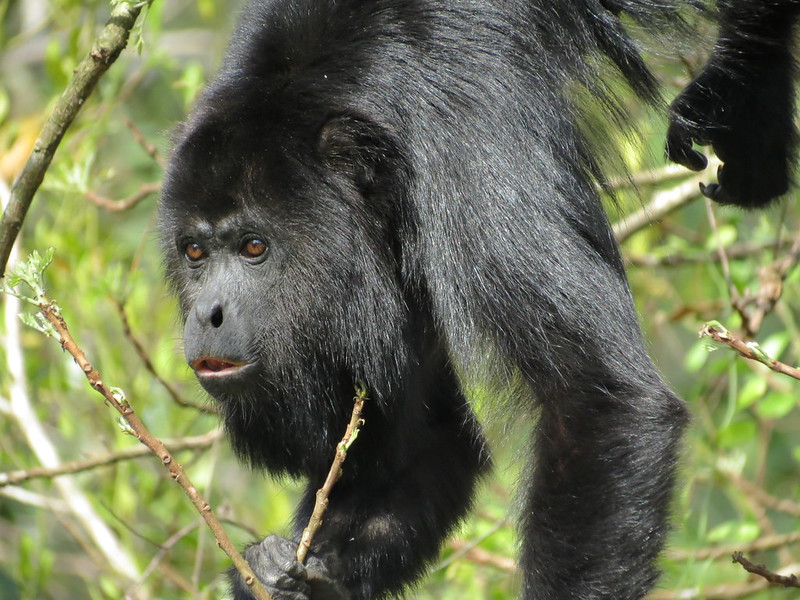
Howler monkeys are known for their impressive vocalizations that can carry for miles across the forest. Native to Central and South America, these primates are primarily leaf eaters, spending much of their time high in the trees. Their prehensile tails act like an extra limb, helping them navigate the dense canopy with ease. Social animals, they live in groups that can range from a few individuals to more than a dozen. The males are typically larger and more vocal than the females. With their loud howls, they effectively defend their territory from other groups.
Spider Monkey
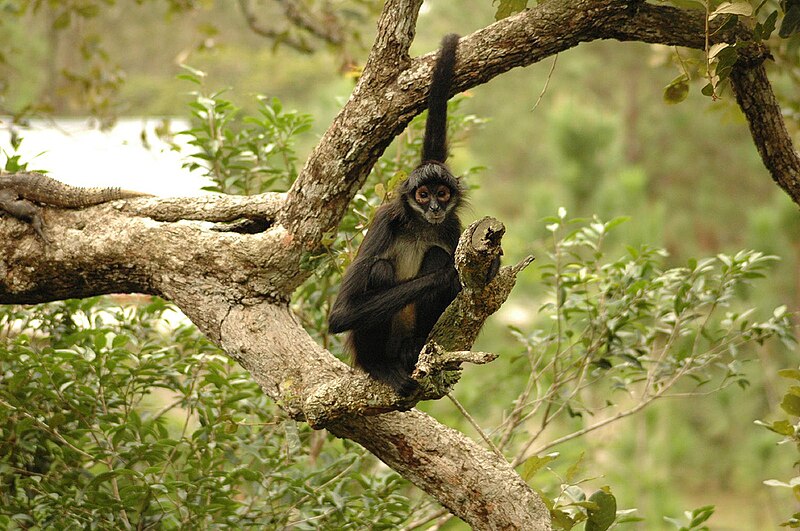
Spider monkeys are aptly named for their long limbs and prehensile tails that resemble the legs of a spider. These agile primates inhabit the forests of Central and South America, where they swing effortlessly from tree to tree. Known for their intelligence, they exhibit complex social behaviors within their groups. They rely heavily on fruit as a food source but will also consume leaves, nuts, and insects. Unlike many other primates, spider monkeys often hang from their tails while feeding or resting. Their large eyes and long tails make them highly adapted to life in the treetops.
Gibbon
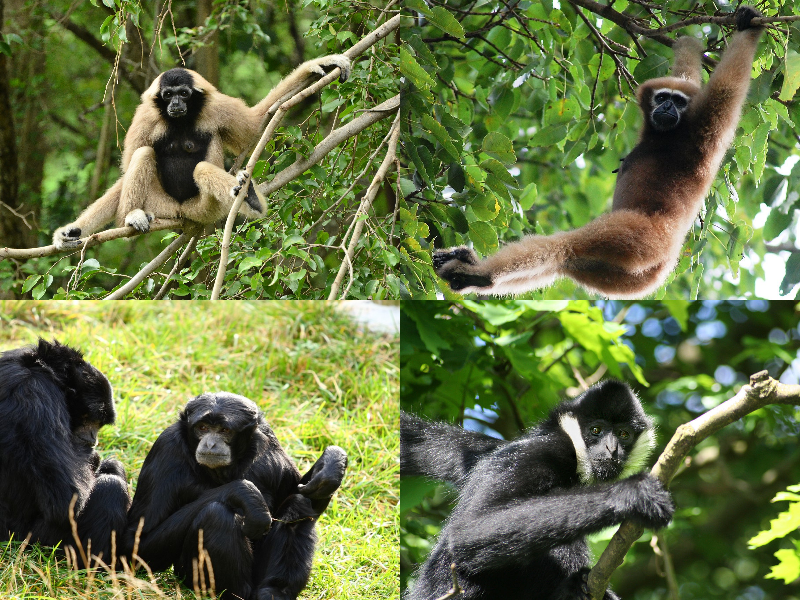
Gibbons, found in Southeast Asia, are small, slender apes that move with remarkable speed and agility through the forest canopy. Using their long arms, they brachiate, swinging from branch to branch with grace. Gibbons are monogamous, forming strong, lifelong bonds with their mates. Their calls, which can be heard from miles away, serve to maintain territory and reinforce pair bonds. Their diet consists mainly of fruit, but they will also eat leaves, flowers, and insects. Often referred to as “lesser apes,” gibbons are smaller than great apes but share similar behavioral traits.
Proboscis Monkey

Native to the lowland rainforests of Borneo, proboscis monkeys are easily recognizable due to their long, protruding noses. These large-nosed primates are excellent swimmers, often diving into rivers to avoid predators. Males, with their larger noses, use them to attract mates and intimidate rivals. Living in troops, they feed on leaves, fruits, and seeds, favoring the upper canopy where food is abundant. They have webbed feet and hands, making them particularly adept at navigating both land and water. Despite their awkward appearance, proboscis monkeys are agile climbers.
Red-Shanked Douc Langur
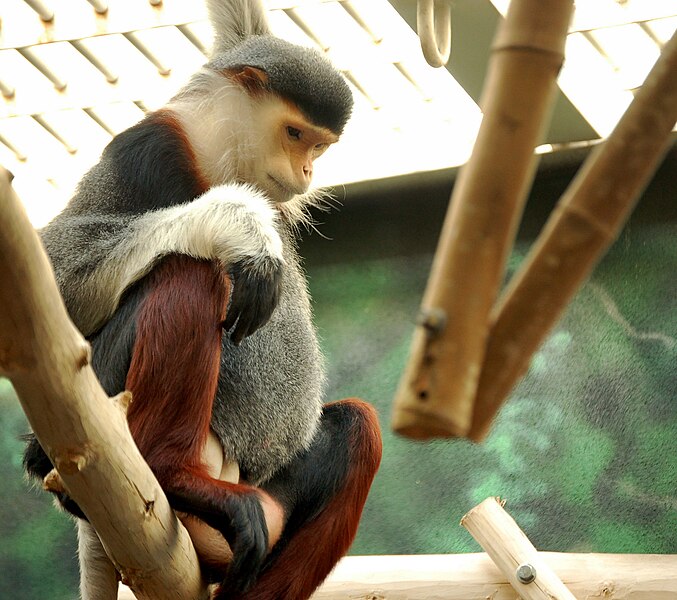
Red-shanked douc langurs are one of the most strikingly colorful primates in the tropical forests of Southeast Asia. Their bright red legs and arms, combined with a patchwork of white, black, and gray fur, make them stand out in the dense canopy. These primates live in large social groups and primarily consume leaves, along with flowers and fruit. They are arboreal, rarely descending to the forest floor, and move through the trees with ease. Their complex vocalizations are used for communication within the group. Despite their beauty, they are critically endangered due to habitat destruction and hunting.
Woolly Monkey
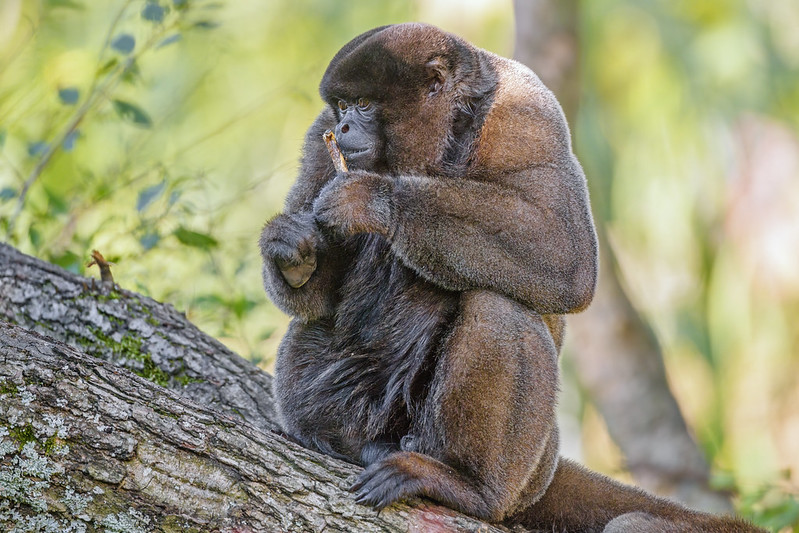
Woolly monkeys, native to the rainforests of the Amazon Basin, are known for their thick, soft fur that helps them adapt to the cooler, misty environment of the high canopy. Their long, prehensile tails are incredibly strong and can support their entire body weight while they forage. Highly social, they live in large groups that maintain strong bonds through grooming and vocal communication. Woolly monkeys primarily eat fruit, but their diet also includes leaves and insects. Unlike many other primates, they exhibit relatively slow and deliberate movements while navigating the treetops. These monkeys are often targeted by hunters for their meat, putting them at risk.
Squirrel Monkey
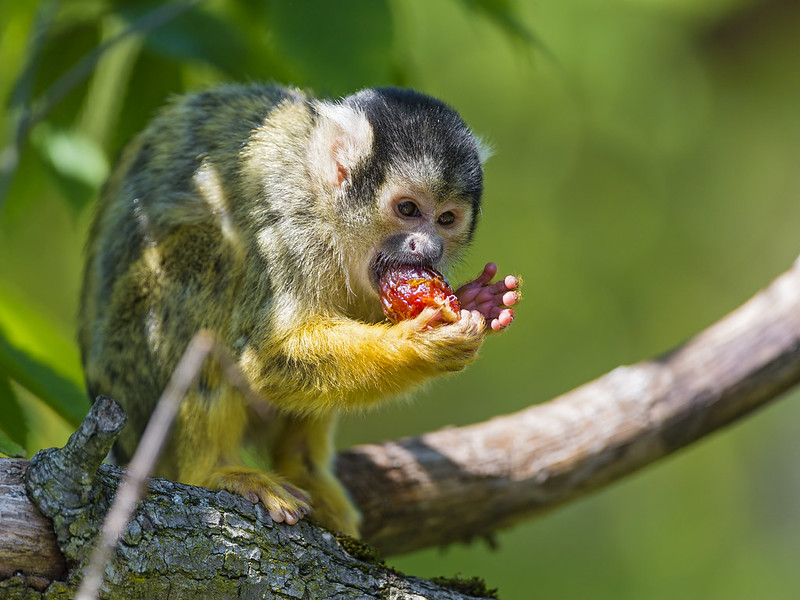
Small and energetic, squirrel monkeys are a common sight in the tropical forests of Central and South America. Weighing only about a pound, they are one of the smallest primates, yet they move quickly through the trees. They live in large troops, sometimes consisting of over 100 individuals, and communicate with high-pitched calls and visual signals. Their diet is omnivorous, including fruit, seeds, and insects. Known for their inquisitive nature, squirrel monkeys are always on the move, exploring their environment. Their large brain relative to their body size is an indicator of their intelligence.
Emperor Tamarin
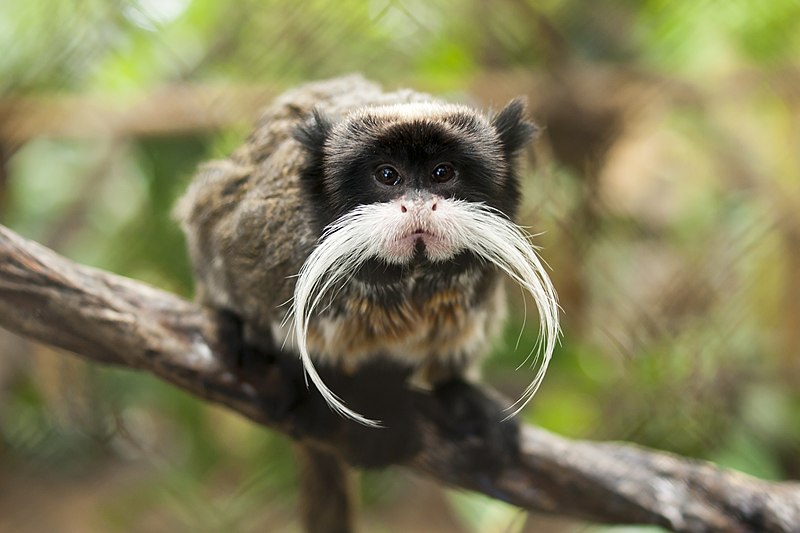
The emperor tamarin is best recognized for its striking white mustache, which contrasts sharply with its dark fur. Native to the Amazon rainforest, this small primate lives in the upper canopy, rarely descending to the ground. They are agile jumpers, using their long tails to maintain balance as they leap between branches. Emperor tamarins are social animals that live in extended family groups, sharing food and caring for one another’s offspring. Their diet consists mainly of fruits, insects, and small vertebrates. Their impressive facial hair is believed to play a role in social communication and hierarchy within the group.
Golden Lion Tamarin
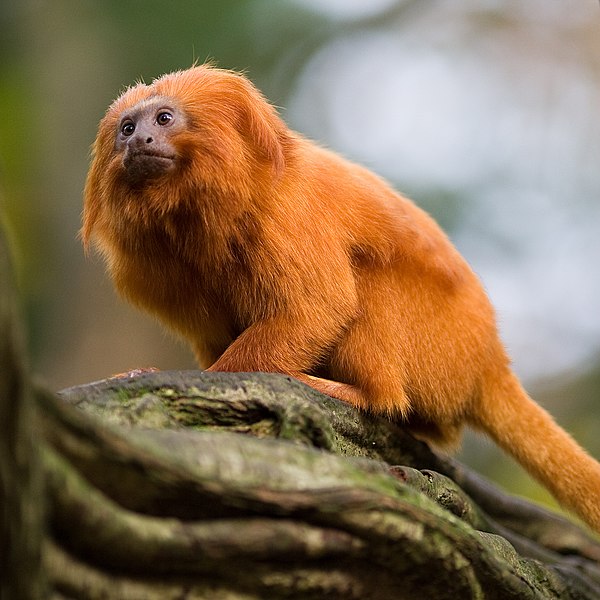
Golden lion tamarins, with their bright orange fur and expressive faces, are some of the most beautiful primates in the world. Found in the Atlantic rainforests of Brazil, these small monkeys are critically endangered due to habitat loss and poaching. They live in small family groups, often consisting of a breeding pair and their offspring. Agile climbers, they use their sharp claws to dig into bark for insects and small prey. Golden lion tamarins also rely on fruit and flowers for sustenance, making them important seed dispersers. Conservation efforts have helped increase their population, but they remain at risk.
Dusky Titi Monkey
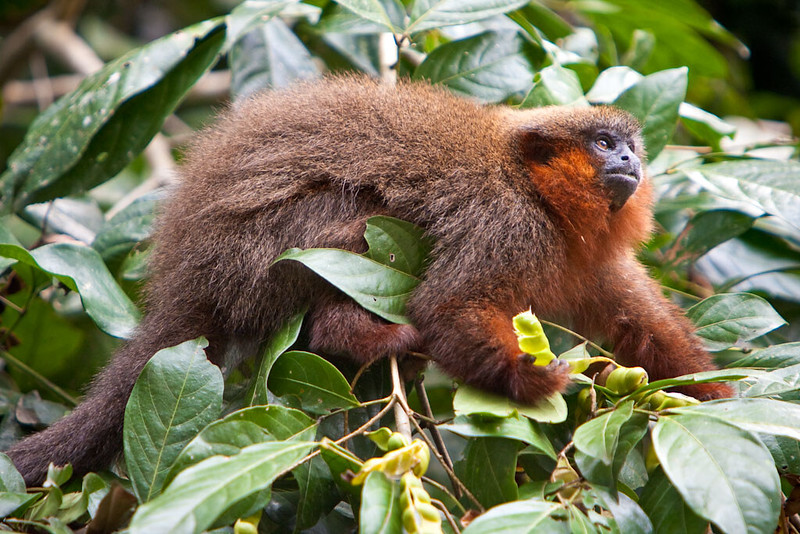
Dusky titi monkeys are small, tree-dwelling primates native to the forests of the Amazon Basin. These monkeys are monogamous, living in pairs with their offspring, and are known for their strong pair bonds. Their diet mainly consists of fruit, but they will also consume leaves and insects. Dusky titi monkeys communicate with soft vocalizations, and their calls are used to maintain territory and keep the family group together. Their thick, brownish-gray fur provides camouflage in the dense canopy, helping them avoid predators. They are shy and elusive, making them difficult to observe in the wild.
Brown-Headed Spider Monkey
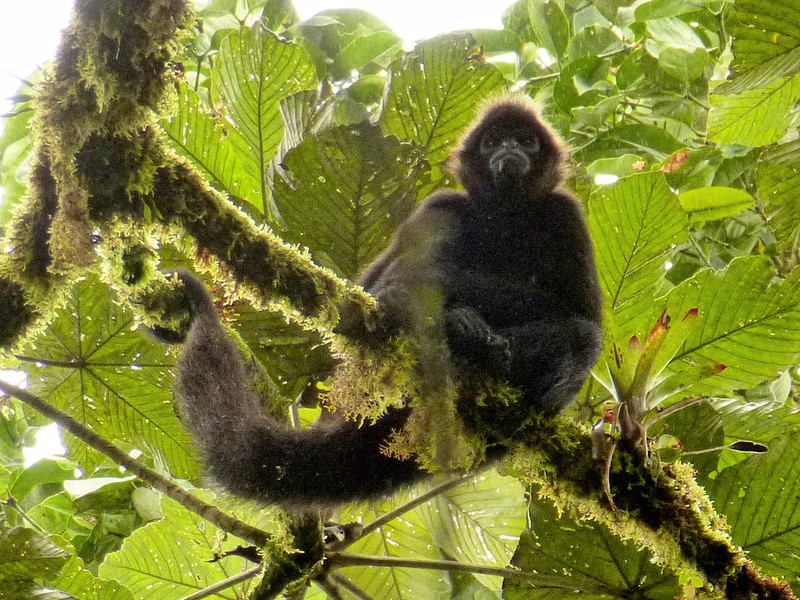
The brown-headed spider monkey is one of the largest species of spider monkeys, found in the tropical forests of Ecuador and Colombia. They are critically endangered due to deforestation and hunting, with only a few thousand individuals remaining in the wild. Known for their long limbs and tails, these primates are skilled at navigating the treetops in search of fruit, leaves, and seeds. They live in fission-fusion societies, where group sizes fluctuate depending on food availability. Brown-headed spider monkeys communicate using vocalizations, facial expressions, and body language. Conservation efforts are underway to protect their remaining habitat and prevent their extinction.
Mantled Howler Monkey
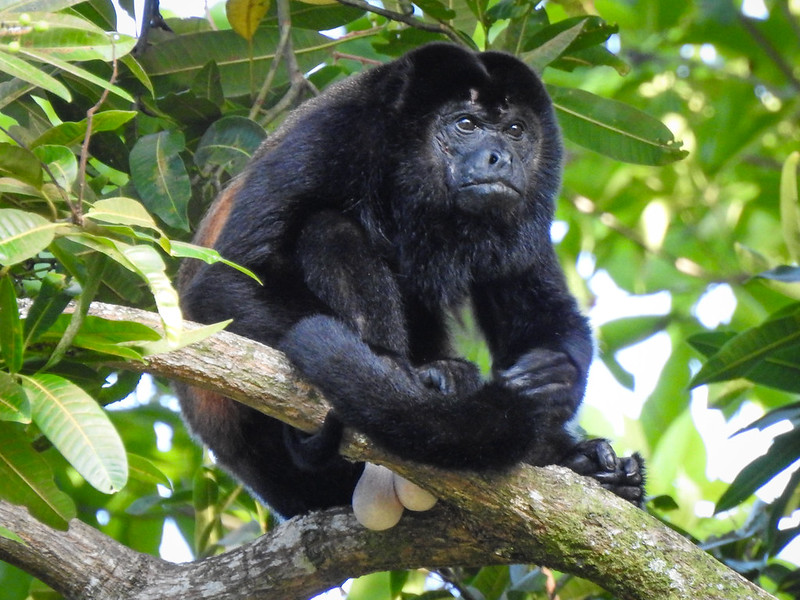
The mantled howler monkey is a large, black primate with a distinctive golden fringe of hair along its sides, giving it its “mantled” appearance. Found in Central and South America, this species is well-known for its loud, guttural howls, which can be heard over great distances. These howls serve as a warning to other groups to stay out of their territory. Mantled howler monkeys are folivores, feeding primarily on leaves, but they will also eat fruits and flowers. They live in large groups, often led by an alpha male, and spend most of their time resting to conserve energy. Their prehensile tails are used to grip branches while feeding or moving through the canopy.
Geoffroy’s Spider Monkey
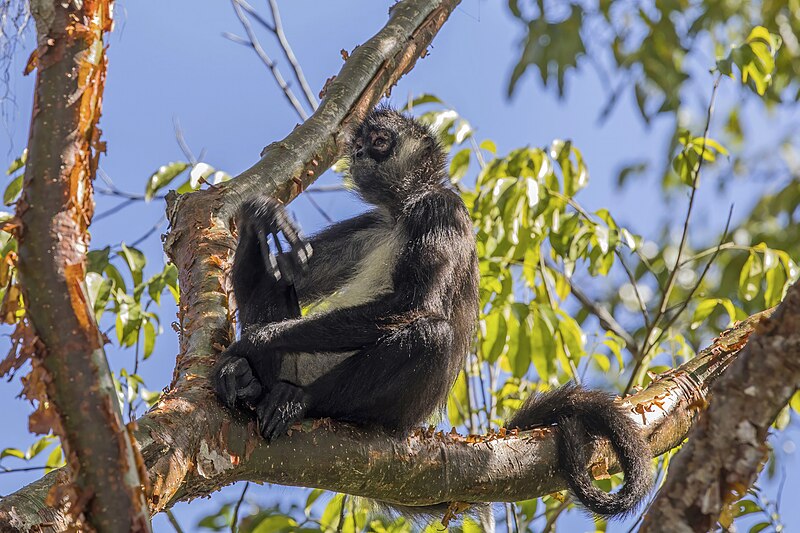
Geoffroy’s spider monkeys are native to Central America, where they thrive in tropical forests with dense canopies. These monkeys are highly social and form large groups that split into smaller factions when foraging for food. Fruit makes up the bulk of their diet, but they will also eat flowers, leaves, and seeds. Their long, slender limbs and prehensile tails make them experts at swinging between trees. Geoffroy’s spider monkeys communicate using a variety of vocalizations, including barks, grunts, and high-pitched calls. They are highly intelligent and have been observed using tools in the wild.
White-Faced Capuchin
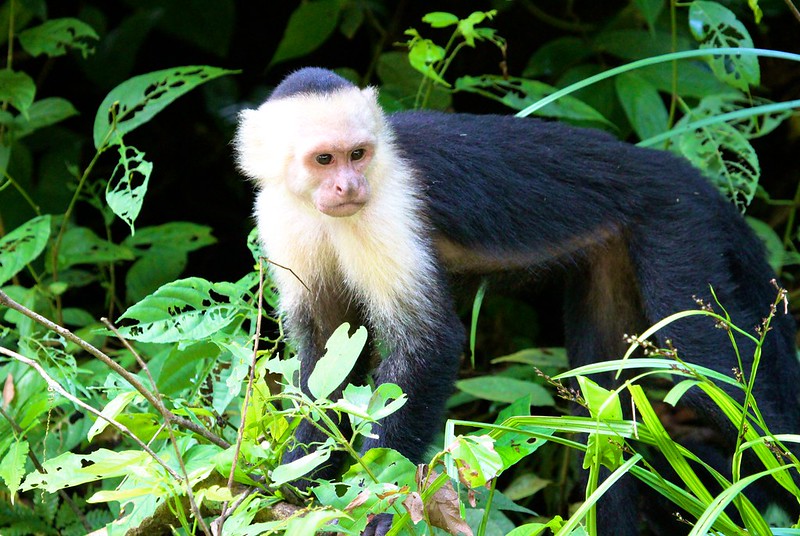
White-faced capuchins are some of the most intelligent primates in the tropical forests of Central and South America. Known for their striking black and white coloration, they are highly adaptable and thrive in various forest types, from dense rainforests to dry deciduous forests. These monkeys are omnivorous, feeding on fruits, insects, small vertebrates, and even birds’ eggs. White-faced capuchins live in social groups led by a dominant male, and they exhibit complex social behaviors such as tool use and cooperative hunting. They are often seen using their prehensile tails for balance as they move swiftly through the treetops.
Pygmy Marmoset
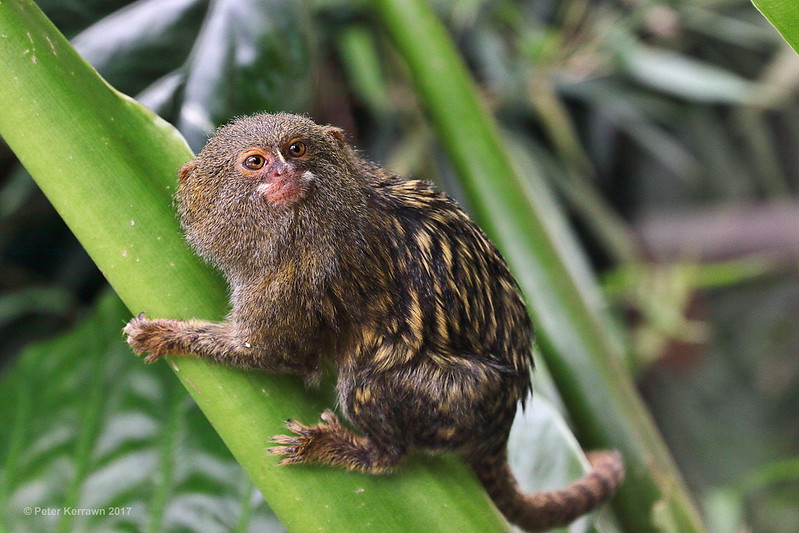
Pygmy marmosets, the smallest monkeys in the world, are native to the rainforests of the Amazon Basin. Weighing just over 3.5 ounces, they are tiny, yet incredibly agile as they leap from branch to branch. These monkeys live in small family groups and communicate using high-pitched whistles and clicks. Their diet consists mainly of tree sap, which they extract by gnawing holes into the bark with their specialized teeth. Despite their size, pygmy marmosets are highly territorial and will fiercely defend their home range from intruders. Their tiny size and camouflage make them difficult to spot in the dense canopy.
Dusky Leaf Monkey

Dusky leaf monkeys, also known as spectacled langurs, are medium-sized primates found in the rainforests of Malaysia and Thailand. Their large, white-ringed eyes give them a unique appearance, reminiscent of wearing glasses. These monkeys live in social groups and primarily feed on leaves, which make up the majority of their diet. Their long tails and limbs allow them to move gracefully through the trees, although they prefer slow, deliberate movements. Dusky leaf monkeys communicate using a series of soft, guttural calls and are generally shy around humans. Habitat loss due to deforestation is their greatest threat.
Golden Snub-Nosed Monkey

Golden snub-nosed monkeys are native to the mountainous forests of China, where they live in some of the most extreme environments for primates. Their thick, golden fur helps them withstand freezing temperatures, and their small, upturned noses prevent frostbite. These monkeys live in large, complex social groups that can number up to 600 individuals. Their diet consists primarily of lichen, supplemented with leaves, fruits, and bark. Despite their remote habitat, golden snub-nosed monkeys are endangered due to habitat loss from logging and human encroachment. Conservation efforts are in place to protect their dwindling populations.
Bald Uakari
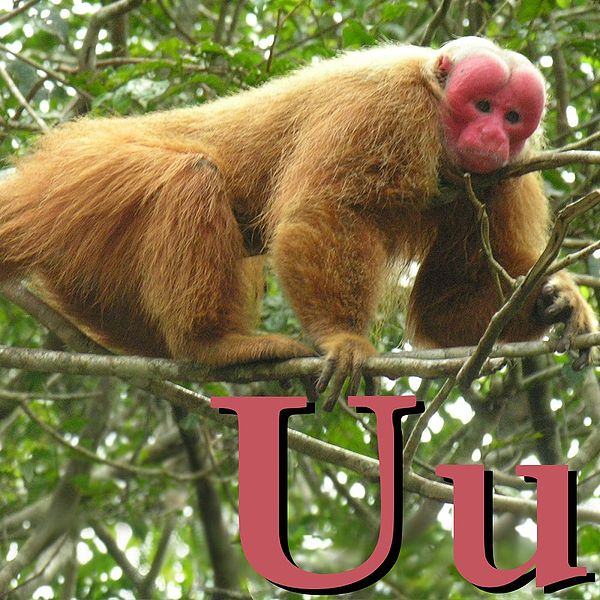
The bald uakari is an unusual-looking primate with a bright red face and a bald head, native to the flooded forests of the Amazon Basin. These monkeys are highly adapted to their environment, using their powerful limbs to move through the treetops in search of fruit, seeds, and insects. Their red facial coloration is an indicator of health, with brighter faces signaling better physical condition. Bald uakaris live in large social groups and are known for their strong bonds and cooperative behavior. They are shy and elusive, often retreating deep into the forest at the sight of humans. Despite their adaptations, they are threatened by habitat destruction and hunting.
This article originally appeared on Rarest.org.
More From Rarest.Org
Ceramics and pottery have long been appreciated for their craftsmanship, but certain pieces go beyond functional items and become true works of art. In this article, we explore a selection of unique ceramic and pottery creations that command premium prices due to their extraordinary designs, techniques, and artistry. Read more.
Rainforests are home to some of the most unique and endangered species on Earth, but many of these creatures are struggling to survive due to habitat destruction, illegal hunting, and climate change. As deforestation continues to accelerate, countless species are losing their homes and access to vital resources, pushing them closer to extinction. Read more.
Board game expansions can add depth and variety to your favorite games, but some rare expansions are worth more than you might expect. These obscure and highly sought-after expansions, often out of print or produced in limited quantities, have gained value over time and are now considered collector’s items. Read more.



